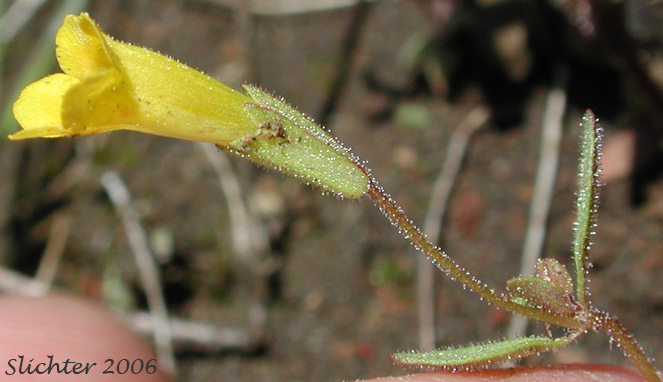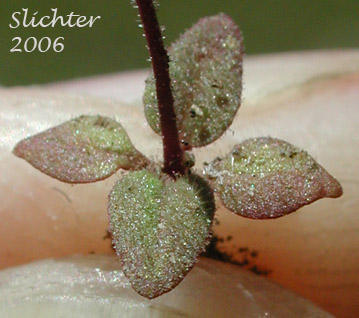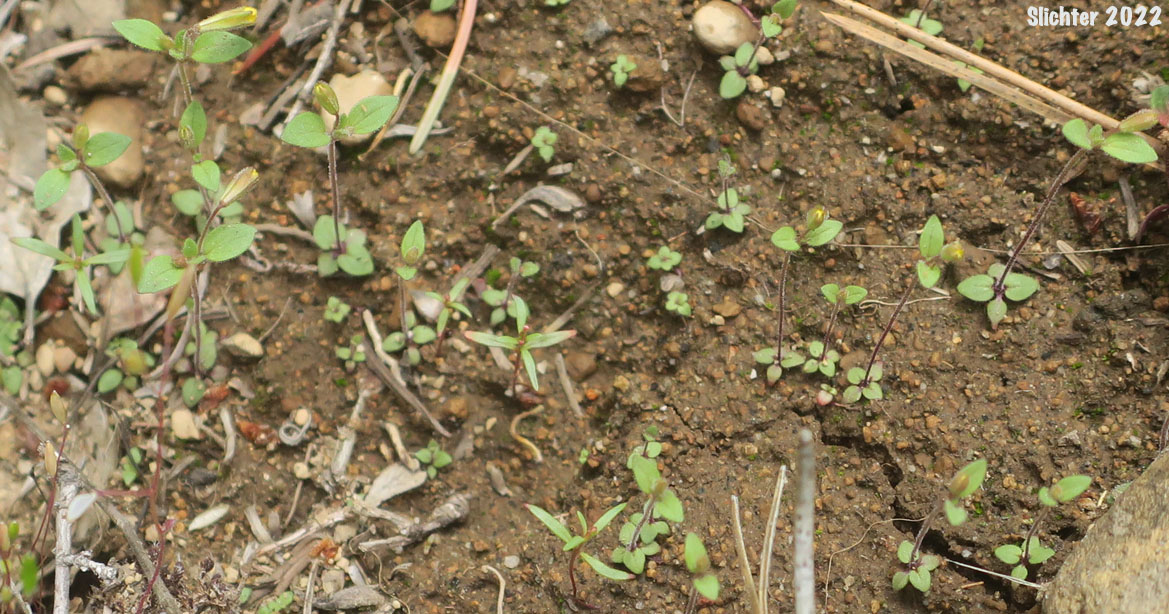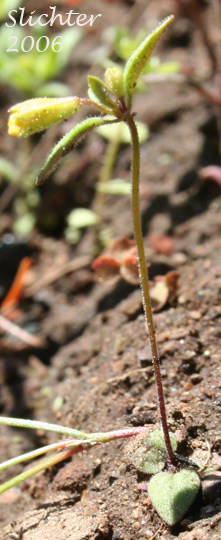Candelabrum Monkeyflower, Pulsifer's Monkeyflower, Pulsifer's Monkey Flower
Erythranthe pulsiferae
Synonym: Mimulus pulsiferae

The photo above shows a close-up view of the
upper stem and flower of candelabrum monkeyflower as seen on
the southeastern side of Mt. Adams.........May 29, 2006. This species
has a lower lip which is slightly longer than the 2 lateral or wing petals.
Note the numerous glands on the stem, both leaf surfaces and calyx, which essentially
has equal calyx teeth.

The photo above shows a close-up view of the mouth of the flower
of candelabrum monkeyflower as seen on the southeastern side
of Mt. Adams..........June 12, 2005. Note the small red dots in
the throat of the flower.

The photo above shows a close-up view of the basal leaves of
candelabrum monkeyflower.
 -
-  -
- 
Candelabrum monkeyflower observed at the southeastern foot of Mt. Adams.......June 3, 2019.
 -
- 

Candelabrum monkeyflower observed on vernally moist balds above the upper Klickitat River east of Mount Adams......June 3, 2022. Two of these images show seedlings, immature plants (in bud) as well as blooming adult plants. The adults are about an inch high.
 -
-  -
- 
The photo at left shows candelabrum monkeyflower as seen at the southeastern foot of Mt. Adams..........June 9, 2007. The photo at center shows candelabrum monkeyflower as seen near 1800' to the southeast of Mt. Adams........May 24, 2016. The photo at right shows several candelabrum monkeyflowers in bloom near 1800' to the southeast of Mt. Adams........June 11, 2020.
 -
-  -
- 
The photo above shows the general form of candelabrum monkeyflower
at the southeastern foot of Mt. Adams...........May
29, 2006.
 -
-  -
- 
Habitat views of Pulsifer's monkeyflower as seen at about 1800' near the southeast side of Mt. Adams. The plant is typically found in shallow, vernally moist swales of clayish substrate or on moist slopes in drainages, typically with lots of open ground among plants (as seen in the photo at left).

The photo above shows the upper stem and a
close-up sideview of the flower of Pulsifer's monkeyflower. Note the large lower
lip of the corolla which is reflexed sharply downward and the numerous hairs
on the palate as well as the numerous gland-tipped hairs on the pedicels and
leaves. Photographed on the eastern slopes of Mt. Adams..........June
17, 2006.

The photo above shows a close-up frontal view
of the flower of Pulsifer's monkeyflower as seen on the eastern slopes of Mt.
Adams..........June 17, 2006. A few reddish spots may be found on
the lower lip into the tube and the palate of this species tends to be fairly
pubescent.

The photo above shows a close-up view of the
upper stem and flower of Pulsifer's monkeyflower as seen on the southeastern
side of Mt. Adams.........June 12, 2005.

The photo above shows a close-up view of the flower and calyx
of Pulsifer's monkeyflower as seen on the southeastern side of Mt. Adams.........June
12, 2005. Note the tiny gland-tipped hairs on the calyx as well as the
roughly equally-sized calyx loes as well as the reflexed corolla lobes.

The photo above shows a close-up view of the a flower and its
pedicel of Pulsifer's monkeyflower as seen on the southeastern side of Mt. Adams..........June
12, 2005.Note that the pedicel is longer than the calyx and that the
lower lip of the corolla is larger than the upper.

The photo above shows a close-up view of the basal leaf and roots
of Pulsifer's monkeyflower as seen on the southeastern side of Mt. Adams..........June
12, 2005.
Paul Slichter
